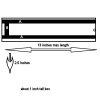twistedminds
New Member
Ok i know the subject was vague but its hard to describe my problem. Ive included picture i did in paint shop. First lets start with the box this will be enclosed in. It cant be more than 13" long. It cant be more the 2.5" wide. And it needs to be around 1" deep. What i need to do is move part B to the point marked C, pretty quickly. It will only weigh at most 1lb. It will sometime have to move vertically. Up or down, the box will move, but the weight will be the most problem vertically for whatever is used to do this. Parts labeled A are in there as RODS to guide the part B. However if its something like a belt driven linear actuator those parts can be eliminated. Basically i need to get Part B to point C pretty quick, and then back to where it started. But i need to be able to keep B at C and then bring it back when i want to. If this is to vague, let me know what else you need to know. Im new with this stuff.

